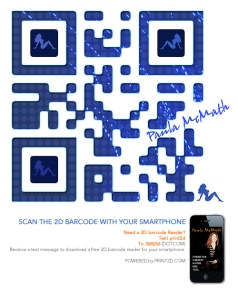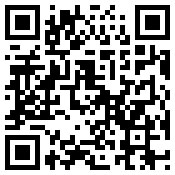
This morning, I found out that a piece I was interviewed for, in December, is airing today on NPR’s Marketplace. Alexandra Schmidt conducted interviews and wrote the piece. It centers on how QR codes are bridging the gap between real life and cyberspace. If you’re interested, you can listen to the spot by cutting and pasting the link included below. The segment starts at about the 14 minute mark. I’m also including the written article in this post.
[ find an easy link to NPR’s Marketplace on the blogroll ] http://marketplace.publicradio.org/display/web/2011/01/21/am-qr-codes-bridge-real-life-with-cyberspace/
I blogged previously about Warbasse Design and how Philip Warbasse designed QR codes for me. You can see previous posts below, Week 20 and Week 17.
The ripple is expanding…
_______________________________________________
QR codes bridge real life with cyberspace

Little black and white squares have started popping up in magazines, on billboards and storefronts. They’re called QR codes, and are aimed at linking the online world with the real world.
This photo taken March 11, 2005, shows a ‘QR Code’ being displayed in a camera-equipped mobile phone in Tokyo. QR Code allows users to enter text information such as name and address on a name card, Internet URL or e-mail address, into mobile phones easily and quickly. (TORU YAMANAKA/AFP/Getty Images)
 The QR Code for marketplace.publicradio.org. (Code courtesy of qrcode.kaywa.com).
The QR Code for marketplace.publicradio.org. (Code courtesy of qrcode.kaywa.com).
TEXT OF STORY
STEVE CHIOTAKIS: You no doubt have seen a bar code. Those line markings on all kinds of products that get scanned at the grocery store checkout. Now there’s a new type of code that’s popping up. Digital codes that link the real world with the online world.
But as reporter Alex Schmidt tells us, a lot of consumers still don’t know what they are.
Alex Schmidt: What they are is QR Codes, which stands for Quick Response. They act kind of like barcodes for your smartphone. You scan these little boxes and a website comes up on your phone. From there, you can get things like coupons or digital downloads.
And advertisers love them. QR designer Phil Warbasse explains why.
Phil Warbasse: What it really does is it turns a five-second pitch into potentially a five minute experience. It extends the time that you have to be in front of your audience.
Warbasse has worked with Chipotle restaurant to put QR codes in a menu, which takes users to a video with celebrities talking about healthy eating. And he’s created one for Paula McMath. She’s a singer who plays weekly on Santa Monica’s 3rd Street Promenade. McMath has her QR codes printed on business cards. When you scan them, they take you to a website where you learn more about her music.
But there’s a potential problem — passersby aren’t quite sure what the barcodes are.
Schmidt: Have you ever seen these?
Man 1: Never in my life.
Man 2: I’ve never seen them before.
Man 3: No.
McMath knows she’s using an early stage technology.
Paula McMath: I realize that on some level, I am a little bit of a guinea pig maybe?
But being experimental could also get her noticed. Lucy Hood directs USC’s Institute for Communication Technology Management.
Lucy Hood: Think about it: you’re a consumer, you’re blobbing along. What’s happening? What will make you pay attention? Something new.
Hood thinks QR codes will need a big, sustained media moment in the spotlight to really drive mass adoption. Sort of like text messaging on “American Idol.” Hood convinced “Idol” producers to use that technology when she worked at Fox back in 2002.
Hood: We went from 12,000 text messages sent to 12 million in one season.
Hood’s guess for QR’s big moment of exposure? She thinks it’ll happen with a movie, sometime this year.
I’m Alex Schmidt for Marketplace.